This is a Konica Recorder DD, a half frame 35mm point and shoot camera made by Konica of Japan starting in 1985. The “DD” in the model name indicates that this was a version of the camera with a data back as compared with the non DD model which was released the year before. The Konica Recorder is the Japanese market version of the Konica AA-35 which was sold in North America. Both cameras came in a variety of different body colors including black, champagne, and red. Regardless of market or color, the specs of each model was the same. All shot half-frame images on regular 35mm film using a vertical film transport which meant that the default orientation of the images was landscape instead of portrait like many other half frame cameras. All models were fully automatic cameras with very little in the way of manual control.
Film Type: 135 (35mm), Half Frame
Lens: 24mm f/4 Konica Hexar coated 4-elements in 4-groups
Focus: 0.9 meters to Infinity, Infrared Active Auto Focus
Viewfinder: Inverted Albada Type Scale Focus with 24mm Projected Frame Lines, 0.41x Magnification
Shutter: Between the Lens Electronic Shutter
Speeds: 1/60 – 1/250 seconds, step less
Exposure Meter: Coupled CdS Cell w/ Full Program Automatic Exposure
Battery: (2x) 1.5v AA Alkaline Battery, 3v CR2025 Battery (for Date Back)
Flash Mount: In-Body Electronic Flash, 0.9 – 4.5m Range, 8 Second Recycle Time
Other Features: Date Back, Electronic Film Load, Advance, and Rewind
Weight: 304 grams
Manual (in Japanese): https://mikeeckman.com/media/KonicaRecorderDDManual.pdf
Manual (similar model, in English): https://www.cameramanuals.org/konica/konica_aa-35_half.pdf
How these ratings work |
The Konica Recorder DD is an update to the original Recorder, a vertically traveling half frame 35mm camera. With a form factor most closely similar to the Fuji TW-3, the Recorder takes on a shape different from other half frame cameras that came before it. Valuing comfort and portability above everything, else, but equipped with a good 4-element Konica Hexar lens and auto focus, packs quite a lot of technology into such a small body. When found in good condition, the Recorder is a fun camera to shoot that affords you a great deal of flexibility. | ||||||
| Images | Handling | Features | Viewfinder | Feel & Beauty | History | Age | |
| 1 | 2 | 2 | 1 | 2 | 1 | 0% | |
| Bonus | +1 for unusual shape and combination of features, a truly innovative camera | ||||||
| Final Score | 10.0 | ||||||
My Thoughts
When it comes to innovative cameras of the 1980s, there are a great many to choose from starting with Nikon’s top of the line F3 released in 1980, to either Minolta or Canon’s all new autofocus SLRs the Maxxum 7000 and EOS 650. There was the Leica M6 rangefinder which has continued to be one of the more desirable 35mm rangefinders of all time. And of course there were the strangely designed “bridge” cameras that started to make their appearance near the end of the decade like the Chinon Genesis and Ricoh Mirai which took the traditional design language of 35mm cameras and completely thrown it out the window in favor of all new shapes and sizes.
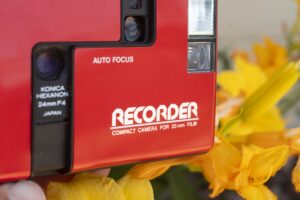
A camera which I think deserves to be on that list of innovative cameras from the 1980s is a relatively unknown half-frame 35mm camera called the Konica AA-35 or the Konica Recorder (depending on market). This unsuspecting rectangular shaped camera doesn’t necessarily do anything different from cameras that came before it, but it took the concept of what a half frame camera should be and fully modernized it, bringing it into the present with auto focus, auto exposure, and easy to load film system, and thanks to its ability to transport film vertically, it composed half frame images in a more familiar landscape orientation.
Now of course, there were many half frame cameras that exposed film vertically like the Canon Dial 35, Yashica Rapide and Sequelle, Taron Chic, and the Soviet Agat 18/18K, and with the exception of the Canon Dial 35, none of these made any significant efforts to improve the ergonomics or handling of the camera.
With the release of the Konica Recorder (called the AA-35 in other markets), for the first time, a 35mm half frame camera had a vertically traveling film compartment, with auto focus, auto exposure, and automatic film advance. The Konica Recorder was the first fully automatic point and shoot 35mm camera. In addition to those firsts, the camera came with a semi-wide angle 4-element in 4-groups glass Hexanon lens, and featured a shutter capable of stepless speeds between 1/60 and 1/250. The list of the Konica Recorder’s features is longer that of current half frame cameras like the Pentax 17 and Kodak Ektar H35 being sold in 2024.
Despite being 40 years old, I found almost no history about this camera online other than it was sold as the Konica AA-35 and Konica Recorder. At one point, I thought the name Recorder was used in Japan only as I’ve seen more Japanese language posts about the Recorder and a Japanese language manual for the Recorder but I have also seen English documentation for the Recorder. In addition, there are versions of the Recorder and possibly the AA-35 with a date back. Models with the date back have a “DD” suffix at the end of the model. Finally, early versions of the AA-35 and Recorder do not support DX film coding, whereas later ones do. It is easy to tell which models have the DX feature as there will be a logo on the front of the camera indicating that it does.
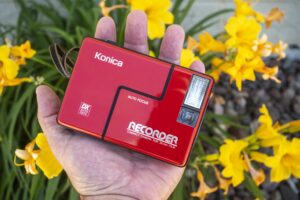
Beyond the differences I stated above, all versions of this camera have the same basic shape, the same 4-element 24mm f/4 lens, same range of shutter speeds, and same metering and focus systems. Versions of the camera came in different colors with the most common being black, red, and a golden champagne color. For the remainder of this article, I will refer to this camera as the Konica Recorder as that’s the model I have, but pretty much everything I say will apply to all of the versions of this camera.
The Konica Recorder was a fully automatic 1980s point a shoot, featuring auto exposure, auto focus, auto film advance and rewind, and auto film loading. To use the camera, you truly just stick in a new cassette, extend the leader to a mark, close the door and press the shutter button until the exposure counter reaches ‘1’ and you’re ready to do. Despite its status as a fully automatic point and shoot, the Konica Recorder does not feel cheap. The outside of the camera has a metal shell which gives it an upscale feel and heft. Although not heavy, at 304 grams with batteries installed, the Recorder feels heavier than it looks. I compared it to a Minolta Disc 7 camera which uses Kodak’s disc format film and the two cameras are identical in height, the Disc camera is almost an inch longer, but the Recorder is about half an inch thicker. Overall though, the Minolta Disc 7 feels like a cheap plastic camera, whereas the Recorder feels like a sturdy, premium camera.
The Konica Recorder lacks a power switch. Instead, turning the camera on and off is done by opening the camera. This is done by pulling the two halves of the camera apart. A zig zag seam runs down the center of the camera and is where the camera separates, revealing the lens twin autofocus sensors and the exposure meter. With the camera open, it locks into position so that it cannot be accidentally closed. In order to close the camera, you must press and hold down on the release switch near the bottom left corner of the back of the camera.
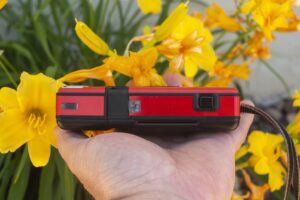
Up top, there is a flash ready indicator that glows orange when the flash is both turned on and has charged the capacitors sufficiently to go off. A small window in the center is for the exposure counter which counts up from S to 72 in increments of 3. Due to the compact size of the camera, there is not enough room to show exactly how many exposures remain, but is good enough for an estimate. Finally, to the right is the rectangular shutter release. The shutter release is a soft press button that when half pressed, activates the metering system which can display a “flash required” light in the viewfinder.
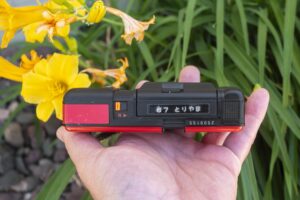
The base of the camera has the opening for the battery compartment and a bright orange Rewind activation switch. The Konica Recorder has a motorized film rewind, it does not activate on its own at the end of a roll. You must press and hold this switch in the direction of the arrow to rewind the film as there is not a tradition rewind crank on the camera. The base of the camera does not have a tripod socket, not that you’d need one anyway.
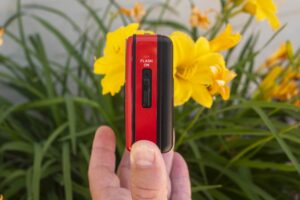
The sides of the camera are unremarkable with the only things being a permanently attached wrist strap on the right and a Flash On switch on the left. The Flash On switch can only be moved when the camera is open. Closing the camera with the switch in the On position will automatically turn it off, to save the battery. While the inclusion of a wrist strap is very nice, that it cannot be removed to be cleaned or replaced with something different is unfortunate. At the very least, it works well.
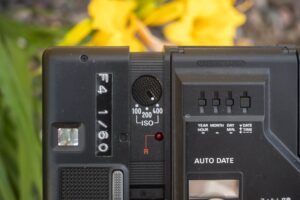
Around back, starting on the left we have the eyepiece for the viewfinder, and the sliding switch for collapsing the camera. With the camera open, inside there is a manual film speed dial with three settings, ISO 100, 200, and 400. For models with the DX encoding feature, the Japanese language manual says that when inserting a compatible DX cassette with a film speed of 100, 200, or 400, the film sensitivity will automatically be set regardless of the position of this switch. The manual clearly shows Konica’s own Sakura 100, 200, and 400 speed films suggesting that these were the emulsions Konica had in mind when designing this camera. It is not clear what the camera will do when DX compatible cassettes outside of these three film speeds are used. Below the film speed dial is a red LED with the letter “R” next to it. This LED illuminates to indicate that the film has reached the end of the roll. The Konica Recorder has a motorized film transport and rewind, however it will not automatically start rewinding the film at the end of the roll. This LED is your indication that you need to use the Rewind switch on the bottom of the camera. A small hole in the sliding cover allows you to still see this LED with the camera closed.
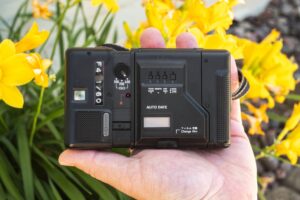
This being the date back version of the camera there are more controls all for various functions, setting the year, month day, hour, and minute, and a small LCD to preview what will be imprinted on the film the next time the shutter is released. Like most date back film cameras from this era, the year setting cannot go past 19 for 2019. Apparently Konica didn’t think people in the year 2024 would still be using the camera! The date back is powered by a separate 3v CR2025 battery which is installed on the inside of the film door. Finally, below the date back LCD is a release slider for opening the top hinged film door.
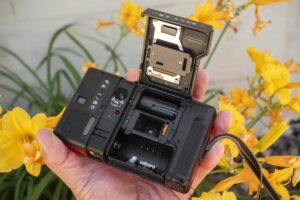
With the film door open, the vertical film compartment is on full display. Like all half-frame cameras, the film gate is half the size of a normal 35mm camera. Film transports from the bottom to top onto a fixed, plastic, and multi-slotted take up spool. The Konica Recorder does not have a quick load feature, so you must still manually attach the leader to one of the slots, and repeatedly press the shutter release to get the spool to rotate enough times to secure the film.
You can see five brass contacts for the DX encoding feature next to a Sakura film sticker in the compartment where the cassette goes. Inside the film door is a small metal pressure plate covered in divots which reduce friction as film passes over it. Next to the pressure plate is the battery compartment for the 3v CR2025 battery for the data back. You’ll need a tiny JIS screwdriver to open the compartment. Foam light seals cover a large part of the hinge side of the film compartment which on this example had completely rotted away. I would need to replace these seals before shooting film to avoid light leaks.
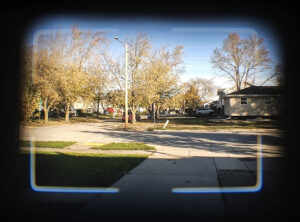
The viewfinder is very basic, showing only projected frame lines estimating what will be captured on film using the 24mm Hexanon lens. Unlike most auto focus cameras, there is not a focus dot or rectangle in the middle of the screen, nor are there any parallax correction marks. The only other thing you can see in the viewfinder is a red LED in the upper left corner which will light up if the meter detects that there is insufficient light to expose the image without the flash. In this case, you’ll need to activate the flash by sliding the switch on the cameras left side to the On position. This will begin charging the flash and when the orange flash ready light on top of the camera is lit, you can make your exposure. If you do not activate the flash when the red LED is illuminated, the camera will still allow you to fire the shutter, but your image will be underexposed. The Recorder’s minimum shutter speed is 1/60, so without support for slow shutter speeds, you really need to rely on the flash.
So far, I’ve talked about the various features of the Konica Recorder and how it works, but one thing that isn’t evident until you handle one, is how well everything works together. Half Frame cameras have always existed in the interest of economy. If film is expensive, then doubling the number of images you can make per roll effectively halves the cost of film. While there have been a great many high quality half frame cameras made over the years, there were also some very basic, entry level models. The Konica Recorder is not one of those. While yes, it does share some similarities with cheap point and and shoot cameras of the 1980s, its attractive metal body, good lens, good ergonomics, and thoughtful combination of features lifts it a step above another cheap point and shoot.
Of course, I could sit here all day telling you the camera is good, but what is it like to shoot? Will the results live up to the praise I have given it thus far? Keep reading…
Konica Recorder DD vs Fuji TW-3
The first time I became aware of the Konica Recorder was back in 2021 when I was working on the review for the Fuji TW-3, another compact point and shoot half-frame camera in which film transports vertically. On the surface, it would seem like the Fuji TW-3 would be a direct competitor to the Konica Recorder, and perhaps for a very narrow window of time, consumers might have compared the two, but after spending some time with both cameras, I can say that despite some similarities on the surface, the two cameras are very different.

Let’s start with some history. Both cameras were available in 1985 by Japanese companies who were building on the previous successes of the half-frame 35mm format which had remained popular in Japan since the release of the Olympus Pen in 1959. Despite being a hotbed of film and camera development, photography has traditionally been more expensive in Japan. During the “hey-day” of half-frame in the 1960s, film was extremely expensive, so consumers looked for ways to get more value out of their photographic dollar. This made half-frame cameras appealing as you could twice as many exposures per roll. The half-frame craze was not limited to Japan as half-frame cameras were produced by nearly every company that made cameras, and became hot items in western countries too. The Olympus Pen series was so popular, it delayed the release of Olympus’s first full frame 35mm SLR by almost a decade.
By the 1970s however, film had gotten more affordable and with more and more compact full frame 35mm options becoming available, the appeal of small cameras whose 17mm x 24mm images caused problems for photofinishers, compact full frame options largely replaced the large numbers of half frame cameras. In the 1980s, the half frame format was extinct everywhere except Japan where it still saw some support by novice photographers who wanted the most compact cameras possible.
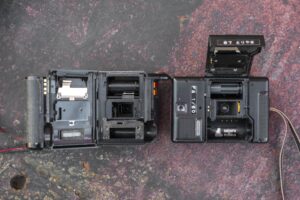
The release of both the Fuji TW-3 and Konica Recorder in the mid 1980s came out of an increased desire to rethink 35mm cameras. Unlike most half frame cameras that came before them, these two models transported film vertically meaning that the default orientation when composing images was landscape, not portrait. Other manufacturers had done this before, Yashica, Taron, and Canon all released half frame cameras with a vertical transport but most of them had strange ergonomics that weren’t familiar to photographers at the time. With an increased use of electronics and light weight and moldable plastics, the time was here to try a new form factor that would meet the needs of the half frame enthusiast without creating a design that was difficult to use.

Whether or not Fuji or Konica knew it at the time, both manufacturers settled on a thin squared shape for their new cameras. Externally, the Fuji TW-3 and Konica Recorder are almost identical in size. When closed, the Konica and Fuji are identical in width and the Fuji is negligibly thicker and taller, however when the Konica is extended into its shooting position, it is about half an inch wider (the Fuji doesn’t need to extend to shoot). Including batteries, the weights of the two are almost the same as well, with the Konica being a mere 15 grams heavier.
Both cameras offered full programmed Auto Exposure without any manual control of the shutter speeds or lens diaphragm. For the shutter, Fuji chose an electronic unit with a wider range of shutter speeds from 1/30 to 1/500, whereas the Konica was limited to 1/60 to 1/250, both were stepless however. Both cameras have built in flashes, with the Fuji’s being a pop-up design and the Konica’s always visible. Both cameras supported motorized film advance and rewind, however the Konica’s rewind feature must be manually activated as the camera won’t automatically begin rewinding at the end of a roll of film.
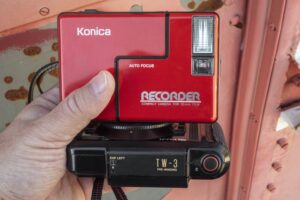
The number of differences between the two cameras is small, but they are significant. It is clear that Fuji and Konica designed these cameras for users with different priorities. A big sign of that is in the lens, or lenses, of the two. The “TW” in the Fuji’s name stands for “Tele and Wide” referring to the dual focal length of the camera’s built in lenses. Featuring both 23mm f/8 and 69mm f/8 Fujinon lenses, the front of the camera can be rotated for different focal lengths. While not a true zoom design, incorporating dual lenses was popular for a brief period during the mid to late 1980s until affordable zoom lenses could be used in point and shoot cameras.
Likely in an effort to keep costs low, the two lenses on the Fuji had slow f/8 maximum apertures with less than 4 elements each. In my review for the Fuji TW-3, I could never discover the makeup of either lens, but it is almost certainly a triplet or possibly even a doublet considering the design and performance. In addition to simpler lenses, the Fuji was manual focus only, featuring a sliding switch with only two zones for the wide angle lens and three for the tele. For the Recorder, Konica used a single 24mm f/4 Hexar lens with a four-element design and full auto focus.

Another major difference is in the power supply for both cameras. Fuji was looking to the future and incorporated two non-replaceable lithium batteries soldered inside of the camera. When new, Fuji boasted that the built in power supply would last at least 5 years or up to 1000 exposures using the flash half of the time. This likely would have been within the normal lifespan of most point and shoot cameras, but certainly limited prolonged use of the camera. Changing the batteries was possible, but required the camera to be partially disassembled and the built in batteries cut out and new ones soldered in their place. Konica was content with using two AA alkaline or equivalent batteries. Not only would these batteries be easy to replace, they ended up not taking up any more space than the built in lithium batteries in the Fuji.
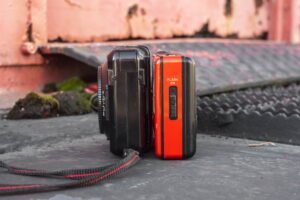
As for the price of the two, I can’t say as I was unable to find any pricing information for either camera when new in the United States or Japan. While it is plausible both cameras were close in price, that the Konica has a nicer metal finish with the availability of different colors suggests that it might have had a slightly more upscale price tag, whereas the Fuji was more of a “gee whiz” dual format manual focus camera with slower and simpler lenses.
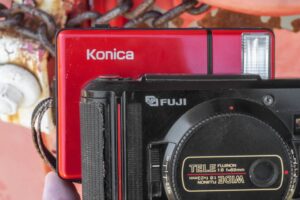
For a collector in 2024, both cameras represent a curious new direction for compact 35mm point and shoot cameras. No other company would release a compact half frame camera in a similar form factor to these, and only Kyocera would produce another vertically traveling half frame camera in the Yashica Samurai SLR. The Konica has a better lens, the advantage of auto focus, and easy to replace AA batteries, but is otherwise an ordinary half frame point and shoot. The Fuji gives you the choice of two different focal lengths, a wider range of shutter speeds, and a body that’s slightly smaller in shooting position. Whichever you choose, both cameras are interesting and worthy of inclusion in your collection, but be prepared to dust off your soldering iron if you want to shoot a Fuji TW-3!
My Results
Having shot the Fuji TW-3 a couple of years ago and being unimpressed with the user interface or the images I got from it, I was eager to try out the Konica Recorder DD. Although I knew these were two very different cameras, the form factor and eras in which they were made are the same so I wanted to know which had the best combination of features. Plus, let’s be honest, the Konica Recorder DD is a really cool looking camera with its collapsible red metal body, so really wanted to like this camera. For the first two rolls, I chose a roll of fresh Fuji 200, and then after that, a small snippet of Kodak TMax 400. I often shoot TMax 100, but chose 400 this time as I was shooting it near the end of winter during a particularly dreary period of weather, and I wanted the two extra stops of light.
For anyone who has read this entire review from start to finish will remember in the section above where I talk about the film compartment, I state that near the door hinge is a large foam light seal which on my example had rotted away and needed to be replaced. Well, I didn’t heed my own advice and shot the color roll of film without realizing that I was ruining nearly every shot with a large swath of orangish red light leaks all over the images. In addition to ruining the images, I suspect it was affecting the camera’s ability to meter as the entire roll was underexposed, despite this cassette having DX coding, which should have correctly set the meter to ISO 200. For the second roll, rather than replace the seals the right way, instead I took several strips of black electrician’s tape and covered all door seams, top and bottom, to keep any unwanted light out.
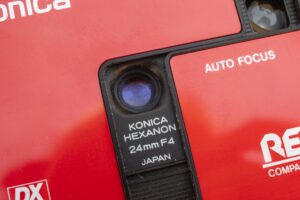
After having a chance to review the scans on a large computer monitor, I was saddened to see that the black and white roll suffered from a tad bit of underexposure too, possibly suggesting something has affected the metering circuit on this camera, causing every image to be underexposed. In each of the images above, I applied some exposure and contrast leveling to boost the images to where they are. Straight off the scanner, shadow detail was thin and grain was very high, especially on the color 200 speed film.
Admittedly, both rolls don’t show the Konica Recorder DD in the best light, and strangely were similar to the lackluster results I got with the Fuji TW-3. A bit of loss of detail is to be expected with any half frame camera as there’s half the surface area to capture details, but I found the images from the Konica to be somewhat vague and lacking in detail, even when considering the smaller image size. Vignetting is apparently in the black and white images and somewhat on the color ones. The autofocus system seemed to work well as I got entire rolls of in focus images, even in low indoor lighting and situations where I used the flash. I have come to expect great things from Konica’s Hexar and Hexanon labeled lenses, and while this was a consumer oriented half frame point and shoot, I was a bit disappointed at the results, but at least acknowledge that I’m using a 39 year old point and shoot with rotted out light seals and questionable operating condition. I do believe that in better circumstances like when this camera was new, it would have been capable of better results than I got here.
Image quality aside, another aspect I was interested in was how enjoyable the Konica was to use as compared to the Fuji. The biggest difference came in the viewfinder, which I chastised the Fuji for its very tiny viewfinder. The one here in the Konica Recorder is acceptably large. Seeing all four sides of the projected frame lines was not a challenge while wearing prescription glasses and I had no issues composing my images. Seeing a natural landscape image on a half frame camera works is a bigger deal than you probably realize as it takes away any unfamiliarity of cameras like the old Olympus Pen or the brand new Pentax 17. If I want to shoot an image in portrait orientation, the square shaped body makes rotating it 90 degrees feel natural.

The ergonomics of the camera were excellent as well. I have what I’d describe as average sized adult male hands and had no issues with gripping the camera comfortably. I found the camera to be neither too big or too small and the location of the shutter release and my ability to securely hold the camera was not impeded in any way. It is clear that this “squarish” form factor for 35mm half frame cameras was a good one and far easier to use than earlier cameras like the Yashica Rapide or Taron Chic.
My biggest gripe with the Konica Recorder DD was its limited shutter speeds. I didn’t mind as much the top 1/250 speed as it worked fine with the films I was using but would have been a downer for those wanting to use faster emulsions. Imagine how fun it would have been to use this as a concert camera, sneaking it inside a coat pocket loaded with some 3200 speed film in low light. I did however find the slowest speed of 1/60 to be a head scratcher. Even the simplest single speed shutter cameras usually have a 1/30 or slower speed. That the Konica Recorder uses an electronically timed shutter, it probably wouldn’t have been difficult for the engineers to give it a couple slower speeds, at least down to 1/15. This would have given you the flexibility of two extra stops of slowness without having to rely on the electronic flash.
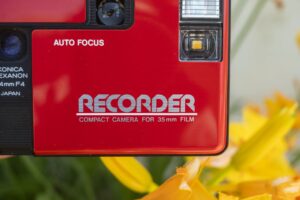
Finally, with a limit on only film speeds 100 to 400, those wanting to shoot faster films in low light or slower speeds to minimize grain would struggle with the Recorder as there is no way to compensate exposure, so I suppose some kind of EV compensation dial would have been a nice addition. This is one area the Fuji TW-3 is better, but only marginally as it supports a range of speeds from 1/30 to 1/500 and does offer a Back Light Compensation button which gives a small element of EV control.
As long as you work within the Konica Recorder’s limitations, this is a pretty sweet little camera. I like the looks, styling, and ergonomics. The faster 4-element Hexar lens should be superior to many inexpensive point and shoot lenses, and the lack of a telephoto lens was not something I missed at all. Shooting half-frame in a vertically traveling camera gives a feeling of familiarity missing from traditional half frame cameras, and although only offering basic functionality, the viewfinder was good enough to where I had no problems with it.
Overall, there’s a lot more to like about the Konica Recorder DD than not like. I do believe that given a choice between two perfectly working cameras, the Fuji TW-3 or this one, the Konica Recorder DD is the winner. These cameras are not common and are even harder to find in the US, but in my mind are worth looking out for. Even if you never shoot it, who doesn’t love a red camera?!
Related Posts You Might Enjoy
External Links
http://camera-wiki.org/wiki/Konica_Recorder
https://www.japancamerahunter.com/2012/07/the-konica-recorder-half-frame-magic/
https://www.analog.cafe/r/konica-recorder-half-frame-point-and-shoot-review-gm7t
https://cameracollector.net/konica-aa-35/
https://www.yaotomi.co.jp/blog/used/2009/07/konicarecorder.html (in Japanese)
https://cameradipc.com/2020/04/12/4935/ (in Japanese)


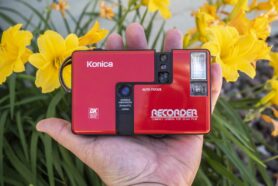
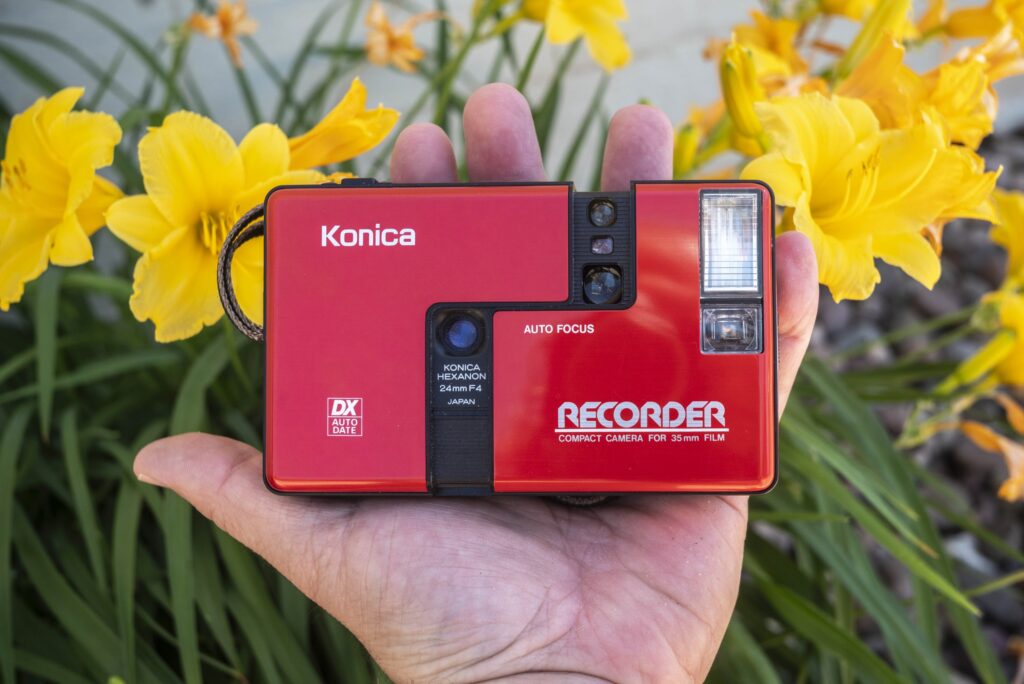
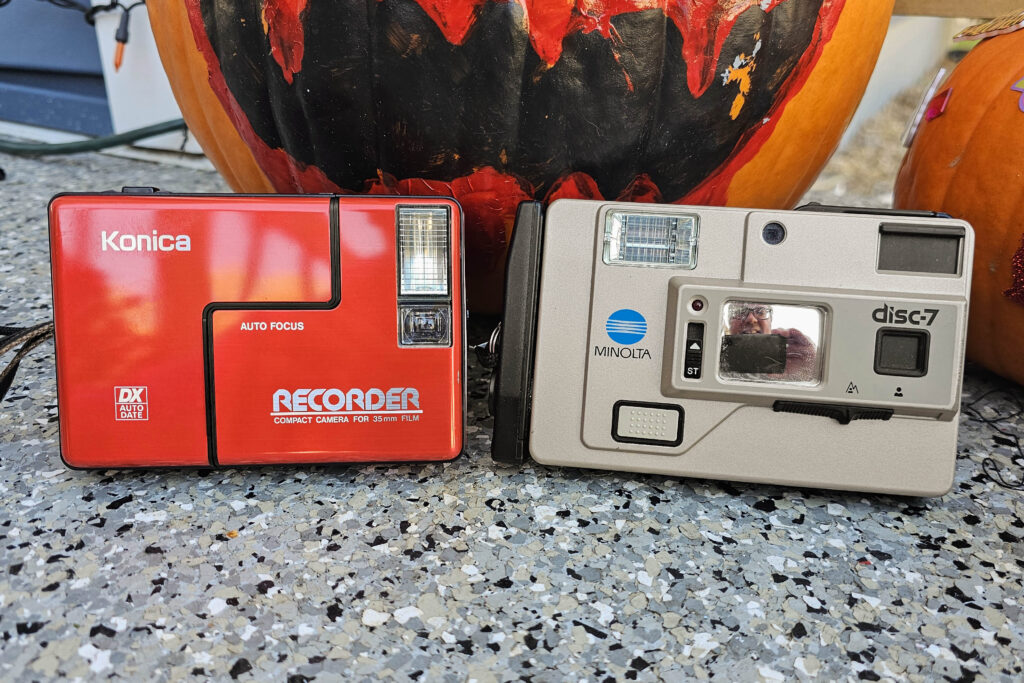
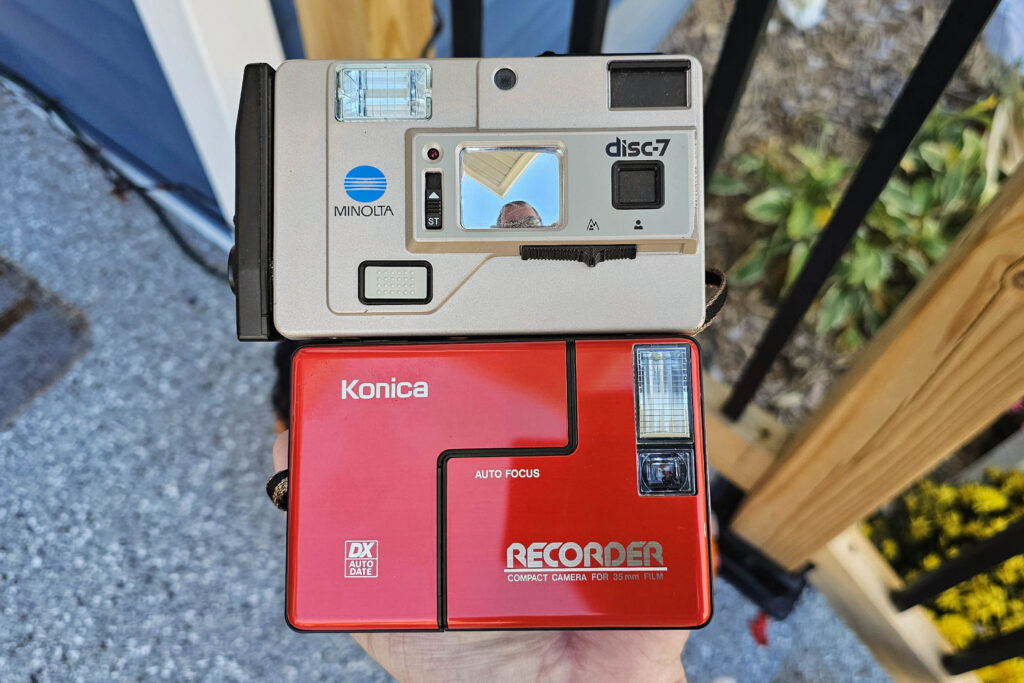
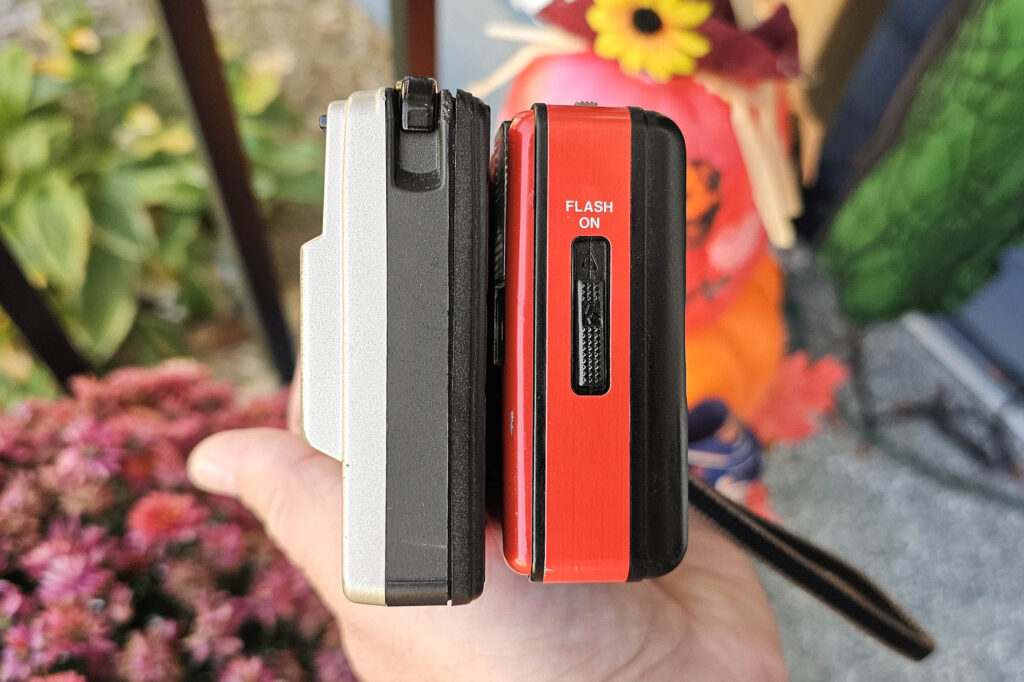


















Please consider doing a comparison review between the Konica Recorder and the new Pentax 17.
I’d love to Roger, but first I’d need to get a Pentax 17! I have so many old cameras that its hard to justify buying a new one!
The non-DX version of this camera would allow +/-1 EV compensation with ISO 200 film, by setting the film speed dial to 100 or 400 as needed for a particular photo
Hi, might be a long shot but I have a question: I read your post about the Konica recorder and I recently bought one for a great price as I love the form factor. The one thing that is slightly broken is the battery cover that is notoriously easy to break it seems. I was wondering if you could take out the cover (it can be taken out pretty easily by taking out two screws ) and send me detailed pictures of it, with a metric ruler in the picture. This way I could 3d model it and design a 3d printable replacement part I could share for anyone to download and print. Would be really helpful of you !
Thanks in advance,
BR Ben